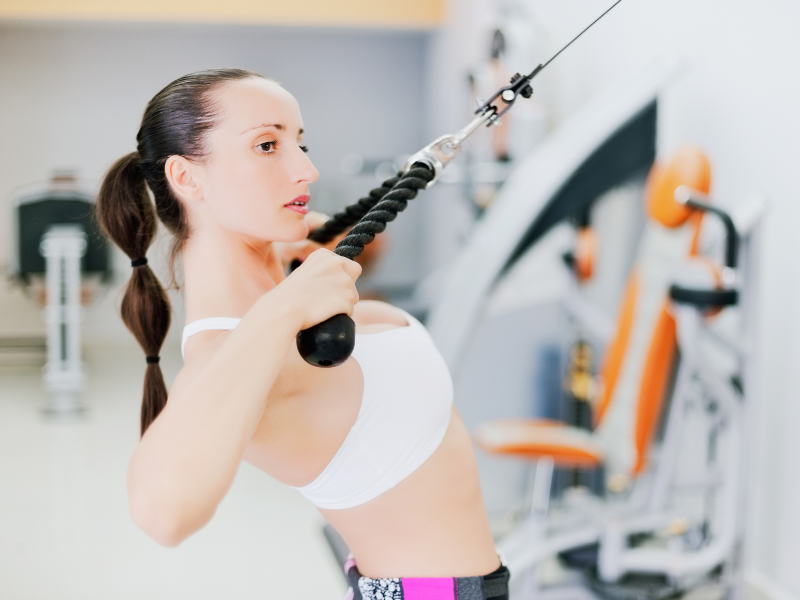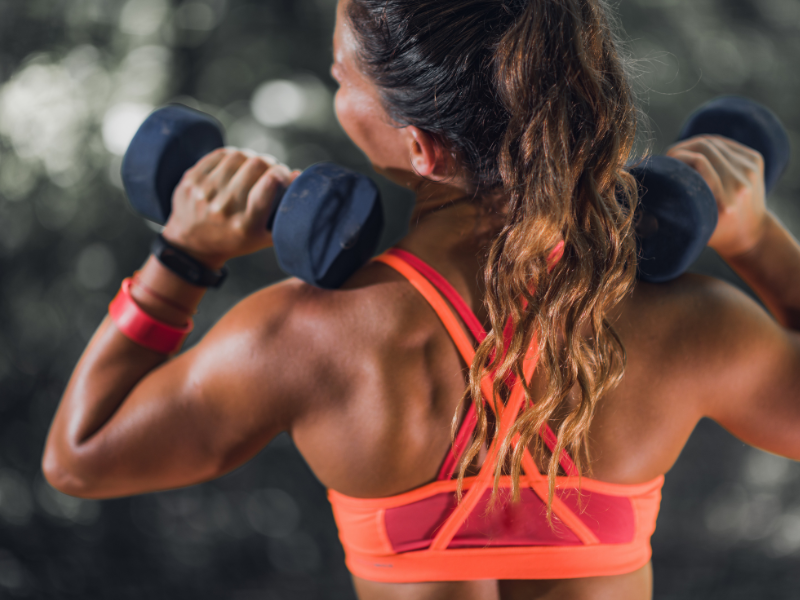


When it comes to building well-rounded shoulders, focusing on the rear delts is crucial. Often neglected, the posterior deltoid muscles provide essential stability, improve posture, and complete the shoulder’s muscular symmetry. In this guide, we will explore the best rear delt exercises to help you incorporate into your shoulder workouts.
Understanding the Rear Delts

The rear delts, also known as the posterior deltoids, are a key muscle group located at the back of your shoulders. These muscles play a crucial role in shoulder extension, external rotation, and overall shoulder stability. The rear delts are responsible for helping to pull the shoulder blades together and downward [1], which is essential for maintaining good posture and preventing injuries.
Understanding the anatomy of the rear delts is important for effective training. The deltoid muscle is a three-headed muscle that consists of the anterior, medial, and posterior heads.
The posterior head is responsible for the extension and rotation of the arm and is the primary muscle targeted by rear delt exercises. By focusing on the posterior deltoids, you can enhance shoulder stability and improve the overall function of your shoulder joint.
You may also like: Shoulder Workouts With Dumbbells: Best Exercises and Routines to Try
Why Train Your Rear Delts? Best Rear Delt Exercises
The rear deltoids, located at the back of your shoulders, play an important role in pulling movements, maintaining shoulder stability, and enhancing overall posture. Well-developed rear delts contribute to a balanced physique and reduce the risk of injury by promoting shoulder health. Without a focus on rear delt training, many people develop imbalances that can hinder performance in both weightlifting and daily activities [2].
1. Bent-Over Dumbbell Reverse Fly

The bent-over dumbbell reverse fly is a classic rear delt exercise that effectively isolates the rear delts. To perform this move:
- How to Do It: Stand with your feet hip-width apart, holding a dumbbell in each hand. Bend your knees slightly and hinge at the hips, keeping your back flat. Lift the dumbbells to the sides, keeping your arms straight with a slight bend in your elbows until they are level with your shoulders. Slowly lower the dumbbells back to the starting position.
- Tips: Focus on a slow and controlled movement, avoiding any jerking motions. It’s better to use lighter weights to ensure proper form and full activation of the rear delts.
2. Face Pulls

Face pulls are an effective and versatile rear delt exercise that can be done using a cable machine or resistance bands. This movement helps to target the rear delts while also working on the muscles of the upper back.
- How to Do It: Attach a rope handle to a cable pulley set at about chest height. Pull the rope towards your face, keeping your elbows high and focusing on squeezing the shoulder blades together. Pause at the peak contraction, then slowly return to the starting position.
- Tips: Keep your shoulders relaxed and avoid shrugging throughout the movement. Control is key. Face pulls are excellent compound exercises that engage multiple muscle groups, including the rear delts and upper back.
3. Rear Delt Cable Pulls

Rear delt cable pulls are a highly effective rear delt exercise that allows for constant tension on the muscle, making them particularly effective for hypertrophy. Using a cable machine helps engage the rear delts throughout the entire range of motion.
- How to Do It: Stand with your feet shoulder-width apart facing the cable machine, and set the pulley at shoulder height. Grab the handle with an overhand grip and pull the cable across your body in a reverse fly motion.
- Tips: Keep a slight bend in your elbow, and focus on squeezing the rear delt at the end of the movement.
You may also like:
Vertical Pull Exercises: 4 Beginner-Friendly Movements To Try
4. Reverse Pec Deck Machine

The reverse pec deck machine is a great option for isolation exercises targeting the rear delts, especially for beginners who may struggle with free weight movements.
- How to Do It: Sit facing the pec deck machine, adjust the handles to the appropriate height, and push them backward, focusing on engaging the rear delts.
- Tips: Make sure to adjust the seat height correctly so that the motion aligns with your shoulders. Ensure that your upper arm is parallel to the floor to maximize engagement of the rear delts.
5. Barbell Face Pulls

While face pulls are commonly done with cables, using a barbell can add variety to your routine and help with progressive overload.
- How to Do It: Using a barbell, pull it towards your upper chest, keeping your elbows up and wide. This movement engages not only the rear delts but also the trapezius and rhomboids.
For a unilateral variation, consider incorporating the single arm dumbbell row to target the rear delts and upper back.
Training Tips and Considerations
When training the rear delts, it’s essential to consider a few key factors to maximize your results. Targeting the rear delt muscles from different angles is crucial for comprehensive development and shoulder health.
First, use a variety of exercises that target the rear delts from different angles. This can include exercises such as the rear delt fly, seated bent-over row, and renegade row. Incorporating different movements ensures that you engage the rear delts fully and promote balanced muscle development.
Second, focus on proper form and technique. Keep your core engaged, squeeze your shoulder blades together, and avoid swinging or jerking the weights. Proper form not only prevents injuries but also ensures that the rear delts are effectively targeted during each exercise.
Third, use a range of weights and reps to challenge the rear delts. Incorporate lighter weights for higher reps to build muscle endurance and heavier weights for lower reps to increase muscle strength. This variety helps in developing both the size and strength of the rear delts.
Finally, integrate rear delt exercises into a well-rounded workout routine that targets all major muscle groups. Exercises such as pull-ups, rows, and shoulder presses can complement your rear delt training and enhance overall upper body strength. By doing so, you ensure a balanced and comprehensive approach to your fitness regimen.
Common Mistakes to Avoid

Using Too Much Weight: Rear delts are smaller muscles, and using excessive weight can compromise form and lead to injury. The rear delt muscles play a crucial role in shoulder mechanics, so it’s important to use proper form and avoid excessive weight to prevent injury. It’s always better to use lighter weights and focus on feeling the contraction in the rear deltoids throughout the entire range of motion. Proper control and form are crucial to ensure you’re isolating and engaging the rear delts effectively.
Neglecting Mind-Muscle Connection: Concentrate on the target muscle throughout each repetition to maximize engagement and effectiveness. Visualize your rear deltoids doing all the work during each movement, and avoid letting other muscles, like the traps or lats, take over. Slow down the movement if needed to help increase the quality of each contraction.
Ignoring Proper Warm-Up: Jumping straight into rear delt exercises without warming up can lead to injury. A good warm-up will increase circulation and prime your muscles, allowing for better performance during your rear delt workout.
Benefits of Rear Delt Training

Training the rear delts helps balance out overall shoulder development, which can prevent injuries caused by muscle imbalances. The rear delt muscles play a crucial role in preventing injuries and improving posture.
Often, people focus heavily on pressing exercises, which predominantly target the front deltoids, resulting in an imbalance that can lead to issues like rounded shoulders, poor posture, and increased risk of injury. Strengthening the rear delts helps to counteract this and create a more balanced shoulder structure.
Strong rear delts also contribute to improved posture by counteracting the forward rounding that can come from a sedentary lifestyle, like sitting at a desk for long hours. Rear delt exercises help open up the chest and pull the shoulders back, leading to a more upright and confident posture, which not only benefits physical health but also your overall appearance.
Making Rear Delt Training a Priority

Including these rear delt exercises in your shoulder workout routine will help you achieve well-rounded shoulder development, better posture, and enhanced upper body strength. Rear delts are often overlooked, but giving them dedicated attention will yield significant benefits for both your aesthetics and shoulder health. Aim to incorporate rear delt exercises 2-3 times a week, depending on your training split, to ensure consistent progress with your upper body.
In addition to strengthening the muscles, rear delt training helps improve the stability and mobility of the shoulder joint [3]. This is especially important for athletes and weightlifters, as healthy shoulder mobility is key to proper execution in a wide variety of exercises, such as overhead movements, Olympic lifts, and even functional movements that are part of daily activities.
Conclusion
For more back workouts and routines, explore the JustFit app for a comprehensive approach! These resources will provide you with diverse exercises that target all parts of the shoulder to help you build a balanced upper body and strong, and healthy shoulders.
What is the best exercise for rear delts?
Should I train rear delts on push or pull day?
Is it bad to not train rear delts?
Campos, Y. A. C., Vianna, J. M., Guimarães, M. P., Oliveira, J. L. D., Hernández-Mosqueira, C., da Silva, S. F., & Marchetti, P. H. (2020). Different Shoulder Exercises Affect the Activation of Deltoid Portions in Resistance-Trained Individuals. Journal of human kinetics, 75, 5–14. Available at: https://doi.org/10.2478/hukin-2020-0033
Paine, R., & Voight, M. L. (2013). The role of the scapula. International journal of sports physical therapy, 8(5), 617–629. Available at: https://www.ncbi.nlm.nih.gov/pmc/articles/PMC3811730/
Schory, A., Bidinger, E., Wolf, J., & Murray, L. (2016). A SYSTEMATIC REVIEW OF THE EXERCISES THAT PRODUCE OPTIMAL MUSCLE RATIOS OF THE SCAPULAR STABILIZERS IN NORMAL SHOULDERS. International journal of sports physical therapy, 11(3), 321–336. Available at: https://pubmed.ncbi.nlm.nih.gov/27274418/





